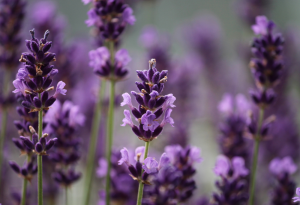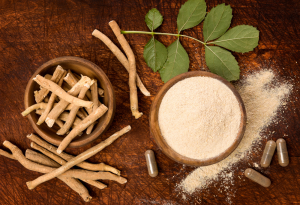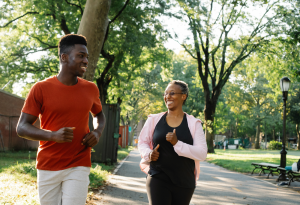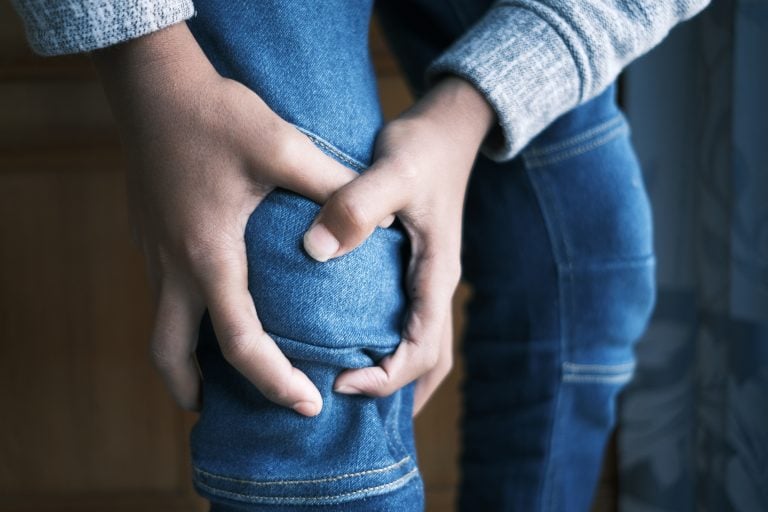Pain is our body’s warning signal that protects us from harm. But when pain becomes chronic, those signals can become a real problem. Whether it’s joint pain, knee pain, neck pain, back pain, or rheumatoid arthritis pain, medication isn’t your only option. What naturally alleviates chronic pain? We sat down with Wu–Hsun Tom Yang, ND, LAc, who practices at the University of Washington’s Sports Medicine Clinic at Ballard, the UW Primary Care Clinic at Northgate, and at Red Leaf Natural Medicine to learn more about how naturopathic doctors approach chronic pain.
What causes chronic pain?
At the first visit with patients experiencing chronic pain, Dr. Yang takes a deep dive into their past and present. “A detailed history is key, especially if something has become chronic,” he explains.
He often sees patients who have chronic muscle tension from sitting at a desk all day. They know that they’ve been tense for a long time, but it may only take one event to cause a pain flare. “[Chronic pain is] a compilation of all the things that have happened to them in the past, or a chronic pattern of tension that we were not aware of before.”
Dr. Yang explores other potential root causes of pain, such as past gut infections or food poisoning incidents, or chronic, inflammatory gut diseases (such as celiac disease, Crohn’s disease, and ulcerative colitis) that may contribute to pain throughout the body and lead to nutrient deficiencies.
There’s also a psychological root cause of chronic pain: the impact of trauma. Dr. Yang’s patients include veterans, firefighters, emergency room staff, teachers, and paramedics. “Over time, these traumas pile up, which can manifest as chronic pain,” he explains. “They may not realize that they have taken on a lot of trauma and are still carrying it after work. And it’s not just musculoskeletal tension. They may have gut health or sleep issues, or increased anxiety and depression.”
Chronic pain is particularly prevalent among U.S. military veterans, affecting approximately one-third of veterans receiving healthcare through the Veterans Health Administration (VHA). A study of Spanish wildland firefighters found that roughly 60 percent reported suffering from chronic pain, with those over 35 years old being four times as likely to suffer from chronic pain.1García-Heras F, Gutiérrez-Arroyo J, León-Guereño P, Carballo-Leyenda B, Rodríguez-Marroyo JA. Chronic Pain in Spanish Wildland Firefighters. J Clin Med. 2022;11(4):989. https://doi.org/10.3390/jcm11040989
Many mental health conditions are also connected to chronic pain, particularly post-traumatic stress disorder and bipolar disorder.2Johnston KJA, Huckins LM. Chronic Pain and Psychiatric Conditions. Complex Psychiatry. 2023;9(1-4):24-43. https://doi.org/10.1159/000527041
Herbal remedies for chronic pain relief
How do you get rid of pain without painkillers? Herbs have been used for centuries worldwide to alleviate chronic pain. Herbs can be taken as supplements or used as essential oils.
Herbs for muscle pain and headaches

For musculoskeletal pain, Dr. Yang commonly recommends frankincense, centella, and curcumin (turmeric) as natural pain relievers. For headaches, he suggests butterbur or feverfew.
Frankincense (Boswellia): One clinical study found this resin extract reduced pain scores in men with chronic prostatitis/chronic pelvic pain syndrome.3Presicce F, Barrese F, Cantiani A, et al. Boswellia resin extract and propolis derived polyphenols in patients with type III chronic prostatitis/chronic pelvic pain syndrome: An Italian prospective multicenter study. Asian J Urol. 2022;9(2):139-145. https://doi.org/10.1016/j.ajur.2021.09.002
Centella Asiatica: Preclinical studies suggest this herb may support jaw comfort, an area of concern in temporomandibular (jaw) conditions.4Rotpenpian N, Wanasuntronwong A, Tapechum S, et al. Standardized Centella asiatica (ECa 233) extract decreased pain hypersensitivity development in a male mouse model of chronic inflammatory temporomandibular disorder. Sci Rep. 2023;13(1):6642. https://doi.org/10.1038/s41598-023-33769-w
Curcumin: Derived from turmeric, curcumin has powerful anti-inflammatory properties. A trial of healthy adults with chronic knee pain found daily administration of a curcumin product for three months alleviated knee pain and improved joint function.5Thanawala S, Shah R, Somepalli V, Alluri KV, Desomayanandam P, Bhuvanendran A. A Multicenter, Randomized, Double-Blind, Placebo-Controlled Trial Assessing Efficacy and Safety of a Novel Low-Dose Turmeric Extract Formulation in Healthy Adults with Chronic Knee Pain. Clin Pharmacol. 2021;13:91-100. https://doi.org/10.2147/CPAA.S307464
Butterbur and feverfew: Clinical studies suggest these herbs may reduce frequency and severity of headaches and migraines.6Grazzi L, Toppo C, D’Amico D, et al. Non-Pharmacological Approaches to Headaches: Non-Invasive Neuromodulation, Nutraceuticals, and Behavioral Approaches. Int J Environ Res Public Health. 2021;18(4):1503. https://doi.org/10.3390/ijerph18041503
Herbs for stress relief and sleep
“When it comes to stress relief and sleep, I think of a category of herbs called nervines,” says Dr. Yang. “They’re gentle but really help us relax. I commonly recommend lemon balm, lavender, rosemary, milky oats, passionflower, skullcap, and chamomile.
Lemon Balm: Supports relaxation, quality sleep, and emotional well-being. Research has shown that lemon balm aids stress management.7Shirazi M, Jalalian MN, Abed M, Ghaemi M. The Effectiveness of Melissa Officinalis L. versus Citalopram on Quality of Life of Menopausal Women with Sleep Disorder: A Randomized Double-Blind Clinical Trial. Rev Bras Ginecol Obstet. 2021;43(2):126-130. https://doi.org/10.1055/s-0040-1721857,8Kenda M, Kočevar Glavač N, Nagy M, Sollner Dolenc M. Medicinal Plants Used for Anxiety, Depression, or Stress Treatment: An Update. Molecules. 2022;27(18):6021. https://doi.org/10.3390/molecules27186021

Lavender, peppermint, and rosemary: Clinical studies suggest that aromatherapy with lavender, peppermint, and rosemary essential oils can promote relaxation, improve sleep quality, and reduce occasional sleep disturbances. These essential oils have been studied for their ability to support restful sleep and help reduce nighttime interruptions.9Cheong MJ, Kim S, Kim JS, et al. A systematic literature review and meta-analysis of the clinical effects of aroma inhalation therapy on sleep problems. Medicine (Baltimore). 2021;100(9):e24652. https://doi.org/10.1097/MD.0000000000024652
Passionflower and skullcap: Clinical research suggests passionflower may support restorative sleep and has been explored for its effects on blood pressure regulation, while skullcap may improve sleep quality.10Janda K, Wojtkowska K, Jakubczyk K, Antoniewicz J, Skonieczna-Żydecka K. Passiflora incarnata in Neuropsychiatric Disorders-A Systematic Review. Nutrients. 2020;12(12):3894. https://doi.org/10.3390/nu12123894,11Hong KB, Han SH, Park Y, Suh HJ, Choi HS. Romaine Lettuce/Skullcap Mixture Improves Sleep Behavior in Vertebrate Models. Biol Pharm Bull. 2018;41(8):1269-1276. https://doi.org/10.1248/bpb.b18-00267
Milky oats and chamomile: Milky oats have been studied for their potential to support a healthy stress response and cognitive function. Clinical research also supports chamomile’s traditional use in promoting relaxation, restful sleep, and emotional well-being.12Kennedy DO, Bonnländer B, Lang SC, et al. Acute and Chronic Effects of Green Oat (Avena sativa) Extract on Cognitive Function and Mood during a Laboratory Stressor in Healthy Adults: A Randomised, Double-Blind, Placebo-Controlled Study in Healthy Humans. Nutrients. 2020;12(6):1598. https://doi.org/10.3390/nu12061598,13Amsterdam JD, Li Y, Soeller I, Rockwell K, Mao JJ, Shults J. A randomized, double-blind, placebo-controlled trial of oral Matricaria recutita (chamomile) extract therapy for generalized anxiety disorder. J Clin Psychopharmacol. 2009;29(4):378-382. https://doi.org/10.1097/JCP.0b013e3181ac935c
Adaptogen herbs to increase stress resilience

“When chronic pain progresses, there’s usually a stress component,” notes Dr. Yang. “That’s when we reach for adaptogens that help people cope with chronic and acute physical or emotional stress: Rhodiola, Schisandra, ashwagandha, astragalus, Centella, and Siberian ginseng help us build our resilience to stressors.”
Rhodiola: Research suggests that Rhodiola’s dual actions of cognitive stimulation and emotional calming may benefit brain function. In one study of adults with life-stress symptoms, Rhodiola supplementation was associated with significant improvements in stress, fatigue, quality of life, and mood.14Edwards D, Heufelder A, Zimmermann A. Therapeutic effects and safety of Rhodiola rosea extract WS® 1375 in subjects with life-stress symptoms–results of an open-label study. Phytother Res. 2012;26(8):1220-1225. https://doi.org/10.1002/ptr.3712
Schisandra and ashwagandha: Both of these herbs have been studied for their adaptogenic effects in supporting the body’s response to stress. In a double-blind clinical trial, ashwagandha supplementation over four months significantly improved psychological well-being and sleep quality.15Gopukumar K, Thanawala S, Somepalli V, Rao TSS, Thamatam VB, Chauhan S. Efficacy and Safety of Ashwagandha Root Extract on Cognitive Functions in Healthy, Stressed Adults: A Randomized, Double-Blind, Placebo-Controlled Study. Evid Based Complement Alternat Med. 2021;2021:8254344. https://doi.org/10.1155/2021/8254344
Supplements and nutrition
“When it comes to nutrients, I often think about magnesium, melatonin, and the B vitamins,” says Dr. Yang. Riboflavin (vitamin B2) can be helpful for migraines, while magnesium helps with stress-induced constipation.”16Haghdoost F, Togha M. Migraine management: Non-pharmacological points for patients and health care professionals. Open Med (Wars). 2022;17(1):1869-1882. https://doi.org/10.1515/med-2022-0598,17Zhang L, Du Z, Li Z, Yu F, Li L. Association of dietary magnesium intake with chronic constipation among US adults: Evidence from the National Health and Nutrition Examination Survey. Food Sci Nutr. 2021;9(12):6634-6641. https://doi.org/10.1002/fsn3.2611
Diet
Dr. Yang recommends that people be mindful of foods they know cause sensitivity or upset stomach. But he also avoids suggesting diets that are too restrictive. He recommends cooked whole foods, which are easier to digest and benefit from.
Inflammation and oxidative stress have been identified as major pathways of chronic pain. Dietary patterns emphasizing anti-inflammatory and antioxidant-rich foods may help reduce pain and improve quality of life. However, the precise foods used depend on the nature and location of the pain.18Seaman DR. The diet-induced proinflammatory state: a cause of chronic pain and other degenerative diseases? J Manipulative Physiol Ther. 2002;25(3):168-179. https://pubmed.ncbi.nlm.nih.gov/11986578/
Holistic activities to reduce muscle pain


Although herbs and supplements can be valuable in supporting comfort and a healthy inflammatory response, lifestyle choices also contribute to overall well-being. “Whether the pain is musculoskeletal, in the gut, or psychological, I always come back to the foundations,” Dr. Yang says. “It’s about good sleep, good digestion, and ways to lessen their pain.”
Exercise and yoga
For Dr. Yang, setting realistic exercise goals with informed patient consent is key. “Many people had enjoyable exercise regimens they had to stop when their chronic pain began,” he explains. “By tapping into those, we invoke curiosity. They see that they are getting stronger, which incentivizes them to continue.”
Research suggests that walking can reduce pain intensity and improve muscle endurance in individuals with chronic low back pain, potentially lowering risk of recurrence. A substantial body of evidence also supports yoga’s role in reducing chronic pain and improving quality of life over the long term.19Suh JH, Kim H, Jung GP, Ko JY, Ryu JS. The effect of lumbar stabilization and walking exercises on chronic low back pain: A randomized controlled trial. Medicine (Baltimore). 2019;98(26):e16173. https://doi.org/10.1097/MD.0000000000016173,20Chopra D, Stern E, Bushell WC, Castle RD. Yoga and pain: A mind-body complex system. Front Pain Res (Lausanne). 2023;4:1075866. https://doi.org/10.3389/fpain.2023.1075866
Some of Dr. Yang’s chronic pain patients’ only outdoor exposure is traveling from one doctor’s office to another. “Sometimes their schedule is packed with medical appointments. They’re tired and in so much pain that they have no energy to do other things. Going gently, then trying to figure out what they’re able to do is key.”
Acupuncture
As a licensed acupuncturist, Dr. Yang often recommends acupuncture for chronic pain.21Huang L, Xu G, Sun M, et al. Recent trends in acupuncture for chronic pain: A bibliometric analysis and review of the literature. Complement Ther Med. 2023;72:102915. https://pubmed.ncbi.nlm.nih.gov/36610367/ He notes that some acupuncture points generate neurotransmitters that can induce a sense of happiness.22Chen Y, Hao C, Chen W, et al. Anti-depressant effects of acupuncture: The insights from NLRP3 mediated pyroptosis and inflammation. Neurosci Lett. 2022;785:136787. https://doi.org/10.1016/j.neulet.2022.136787 “Anytime a needle goes through the skin, your body has an immune response. That can mean getting more immune cells to the area to generate more potential for healing and remodeling, and more blood flow to the area, [which may contribute to] circulation or nerve regeneration.”23Kubo K, Iizuka Y, Yajima H, Takayama M, Takakura N. Changes in Blood Circulation of the Tendons and Heart Rate Variability During and After Acupuncture. Med Acupunct. 2020;32(2):99-107. https://doi.org/10.1089/acu.2019.1397
Mindset

Dr. Yang doesn’t think that there is one correct mindset to reduce chronic pain. Instead, he tries to set realistic expectations. “I tell patients that chronic pain is a journey, just like grief,” he says. “There will be ups and downs. There will be weeks [when] they feel better and weeks [when] they feel worse. It’s not necessarily about hitting milestones and never regressing.”24Bruce M, Lopatina E, Hodge J, et al. Understanding the chronic pain journey and coping strategies that patients use to manage their chronic pain: a qualitative, patient-led, Canadian study. BMJ Open. 2023;13(7):e072048. https://doi.org/10.1136/bmjopen-2023-072048
He also recommends his patients engage in positive self-talk and take an active role in their treatment. “We are there to facilitate their health, not dictate their health. I don’t want the patient to feel like everything hinges on the practitioner.”
When should I use conventional treatments?
Conventional treatments for chronic pain usually involve over-the-counter or prescription medications such as NSAIDs (nonsteroidal anti-inflammatory drugs) or opioids, as well as cognitive behavioral therapy.25Heath L, Philip A. Chronic pain care: time for excellence. Fam Med Community Health. 2020;8(2):e000285. https://doi.org/10.1136/fmch-2019-000285
Dr. Yang recommends acute pain flares as a good time to consider pharmaceuticals. Temporarily reducing pain can help patients implement longer-term lifestyle recommendations. He also reminds patients that they don’t have to take medications indefinitely. “With chronic pain,” he notes, “patients often get a lot of medication. Half the time, they don’t remember what those medications are for. Over-the-counter pain medications may help at first, but over time, people find them less effective, even when they are at the maximum dose.” Dr. Yang asks his patients what has worked (and what hasn’t) to reduce their pain in the past so he can find the best strategy for each person.
What are the possible side effects of pain medication?

Potential adverse effects of NSAIDs can impact many body systems, including the gut, kidneys, heart, and liver.26Ghlichloo I, Gerriets V. Nonsteroidal Anti-inflammatory Drugs (NSAIDs). In: StatPearls. StatPearls Publishing; 2023. Accessed August 1, 2023. https://www.ncbi.nlm.nih.gov/books/NBK547742/ Addiction to opioid medication is now at epidemic levels; approximately three million Americans have had or currently suffer from opioid use disorder.27Azadfard M, Huecker MR, Leaming JM. Opioid Addiction. In: StatPearls. StatPearls Publishing; 2023. Accessed August 1, 2023. https://www.ncbi.nlm.nih.gov/books/NBK448203/
“Before considering something stronger, it’s important to look at the exact nature of their pain and see if referrals are indicated,” says Dr. Yang. “Whether it’s acupuncture, physical therapy, therapeutic massage, or counseling, could those be more appropriate before they consider opioids?”
Dr. Yang has seen a paradigm change, where patients are seeking holistic options to prevent pain medication dependency. The conventional medical profession is following suit. “In the past six or seven years, there has been a shift,” he notes. “Most clinicians and medical offices now have very stringent monitoring protocols to make sure that people are using them as indicated, not overusing them, and not replacing them with other pain medications.”28Dowell D, Ragan KR, Jones CM, Baldwin GT, Chou R. CDC Clinical Practice Guideline for Prescribing Opioids for Pain—United States, 2022. MMWR Recomm Rep. 2022;71(3):1-95. https://doi.org/10.15585/mmwr.rr7103a1
Dr. Yang also sees conventional doctors gaining a better appreciation for how the naturopathic approach can support patients experiencing chronic pain. “We’re seeing more and more large medical centers take chronic pain management in a more integrative direction. We see more exercise, counseling, group sessions, nutrients, and herbs being recommended as part of their integrative approach to chronic pain. But naturopathic doctors are ahead of that game! We are already trained in these treatments. The wait can be quite long to get into chronic pain centers. That’s another reason why people should give naturopathic doctors a chance—to see what all their options are for managing their pain. It doesn’t have to be mutually exclusive to conventional care; it can be complementary.”
Footnotes
- 1García-Heras F, Gutiérrez-Arroyo J, León-Guereño P, Carballo-Leyenda B, Rodríguez-Marroyo JA. Chronic Pain in Spanish Wildland Firefighters. J Clin Med. 2022;11(4):989. https://doi.org/10.3390/jcm11040989
- 2Johnston KJA, Huckins LM. Chronic Pain and Psychiatric Conditions. Complex Psychiatry. 2023;9(1-4):24-43. https://doi.org/10.1159/000527041
- 3Presicce F, Barrese F, Cantiani A, et al. Boswellia resin extract and propolis derived polyphenols in patients with type III chronic prostatitis/chronic pelvic pain syndrome: An Italian prospective multicenter study. Asian J Urol. 2022;9(2):139-145. https://doi.org/10.1016/j.ajur.2021.09.002
- 4Rotpenpian N, Wanasuntronwong A, Tapechum S, et al. Standardized Centella asiatica (ECa 233) extract decreased pain hypersensitivity development in a male mouse model of chronic inflammatory temporomandibular disorder. Sci Rep. 2023;13(1):6642. https://doi.org/10.1038/s41598-023-33769-w
- 5Thanawala S, Shah R, Somepalli V, Alluri KV, Desomayanandam P, Bhuvanendran A. A Multicenter, Randomized, Double-Blind, Placebo-Controlled Trial Assessing Efficacy and Safety of a Novel Low-Dose Turmeric Extract Formulation in Healthy Adults with Chronic Knee Pain. Clin Pharmacol. 2021;13:91-100. https://doi.org/10.2147/CPAA.S307464
- 6Grazzi L, Toppo C, D’Amico D, et al. Non-Pharmacological Approaches to Headaches: Non-Invasive Neuromodulation, Nutraceuticals, and Behavioral Approaches. Int J Environ Res Public Health. 2021;18(4):1503. https://doi.org/10.3390/ijerph18041503
- 7Shirazi M, Jalalian MN, Abed M, Ghaemi M. The Effectiveness of Melissa Officinalis L. versus Citalopram on Quality of Life of Menopausal Women with Sleep Disorder: A Randomized Double-Blind Clinical Trial. Rev Bras Ginecol Obstet. 2021;43(2):126-130. https://doi.org/10.1055/s-0040-1721857
- 8Kenda M, Kočevar Glavač N, Nagy M, Sollner Dolenc M. Medicinal Plants Used for Anxiety, Depression, or Stress Treatment: An Update. Molecules. 2022;27(18):6021. https://doi.org/10.3390/molecules27186021
- 9Cheong MJ, Kim S, Kim JS, et al. A systematic literature review and meta-analysis of the clinical effects of aroma inhalation therapy on sleep problems. Medicine (Baltimore). 2021;100(9):e24652. https://doi.org/10.1097/MD.0000000000024652
- 10Janda K, Wojtkowska K, Jakubczyk K, Antoniewicz J, Skonieczna-Żydecka K. Passiflora incarnata in Neuropsychiatric Disorders-A Systematic Review. Nutrients. 2020;12(12):3894. https://doi.org/10.3390/nu12123894
- 11Hong KB, Han SH, Park Y, Suh HJ, Choi HS. Romaine Lettuce/Skullcap Mixture Improves Sleep Behavior in Vertebrate Models. Biol Pharm Bull. 2018;41(8):1269-1276. https://doi.org/10.1248/bpb.b18-00267
- 12Kennedy DO, Bonnländer B, Lang SC, et al. Acute and Chronic Effects of Green Oat (Avena sativa) Extract on Cognitive Function and Mood during a Laboratory Stressor in Healthy Adults: A Randomised, Double-Blind, Placebo-Controlled Study in Healthy Humans. Nutrients. 2020;12(6):1598. https://doi.org/10.3390/nu12061598
- 13Amsterdam JD, Li Y, Soeller I, Rockwell K, Mao JJ, Shults J. A randomized, double-blind, placebo-controlled trial of oral Matricaria recutita (chamomile) extract therapy for generalized anxiety disorder. J Clin Psychopharmacol. 2009;29(4):378-382. https://doi.org/10.1097/JCP.0b013e3181ac935c
- 14Edwards D, Heufelder A, Zimmermann A. Therapeutic effects and safety of Rhodiola rosea extract WS® 1375 in subjects with life-stress symptoms–results of an open-label study. Phytother Res. 2012;26(8):1220-1225. https://doi.org/10.1002/ptr.3712
- 15Gopukumar K, Thanawala S, Somepalli V, Rao TSS, Thamatam VB, Chauhan S. Efficacy and Safety of Ashwagandha Root Extract on Cognitive Functions in Healthy, Stressed Adults: A Randomized, Double-Blind, Placebo-Controlled Study. Evid Based Complement Alternat Med. 2021;2021:8254344. https://doi.org/10.1155/2021/8254344
- 16Haghdoost F, Togha M. Migraine management: Non-pharmacological points for patients and health care professionals. Open Med (Wars). 2022;17(1):1869-1882. https://doi.org/10.1515/med-2022-0598
- 17Zhang L, Du Z, Li Z, Yu F, Li L. Association of dietary magnesium intake with chronic constipation among US adults: Evidence from the National Health and Nutrition Examination Survey. Food Sci Nutr. 2021;9(12):6634-6641. https://doi.org/10.1002/fsn3.2611
- 18Seaman DR. The diet-induced proinflammatory state: a cause of chronic pain and other degenerative diseases? J Manipulative Physiol Ther. 2002;25(3):168-179. https://pubmed.ncbi.nlm.nih.gov/11986578/
- 19Suh JH, Kim H, Jung GP, Ko JY, Ryu JS. The effect of lumbar stabilization and walking exercises on chronic low back pain: A randomized controlled trial. Medicine (Baltimore). 2019;98(26):e16173. https://doi.org/10.1097/MD.0000000000016173
- 20Chopra D, Stern E, Bushell WC, Castle RD. Yoga and pain: A mind-body complex system. Front Pain Res (Lausanne). 2023;4:1075866. https://doi.org/10.3389/fpain.2023.1075866
- 21Huang L, Xu G, Sun M, et al. Recent trends in acupuncture for chronic pain: A bibliometric analysis and review of the literature. Complement Ther Med. 2023;72:102915. https://pubmed.ncbi.nlm.nih.gov/36610367/
- 22Chen Y, Hao C, Chen W, et al. Anti-depressant effects of acupuncture: The insights from NLRP3 mediated pyroptosis and inflammation. Neurosci Lett. 2022;785:136787. https://doi.org/10.1016/j.neulet.2022.136787
- 23Kubo K, Iizuka Y, Yajima H, Takayama M, Takakura N. Changes in Blood Circulation of the Tendons and Heart Rate Variability During and After Acupuncture. Med Acupunct. 2020;32(2):99-107. https://doi.org/10.1089/acu.2019.1397
- 24Bruce M, Lopatina E, Hodge J, et al. Understanding the chronic pain journey and coping strategies that patients use to manage their chronic pain: a qualitative, patient-led, Canadian study. BMJ Open. 2023;13(7):e072048. https://doi.org/10.1136/bmjopen-2023-072048
- 25Heath L, Philip A. Chronic pain care: time for excellence. Fam Med Community Health. 2020;8(2):e000285. https://doi.org/10.1136/fmch-2019-000285
- 26Ghlichloo I, Gerriets V. Nonsteroidal Anti-inflammatory Drugs (NSAIDs). In: StatPearls. StatPearls Publishing; 2023. Accessed August 1, 2023. https://www.ncbi.nlm.nih.gov/books/NBK547742/
- 27Azadfard M, Huecker MR, Leaming JM. Opioid Addiction. In: StatPearls. StatPearls Publishing; 2023. Accessed August 1, 2023. https://www.ncbi.nlm.nih.gov/books/NBK448203/
- 28Dowell D, Ragan KR, Jones CM, Baldwin GT, Chou R. CDC Clinical Practice Guideline for Prescribing Opioids for Pain—United States, 2022. MMWR Recomm Rep. 2022;71(3):1-95. https://doi.org/10.15585/mmwr.rr7103a1





